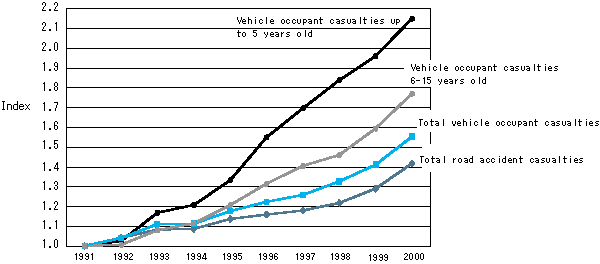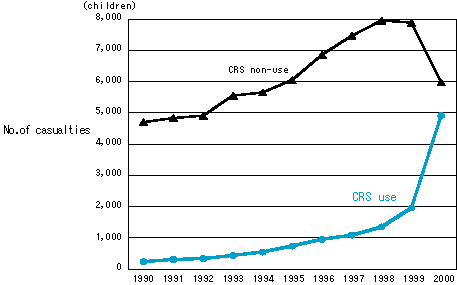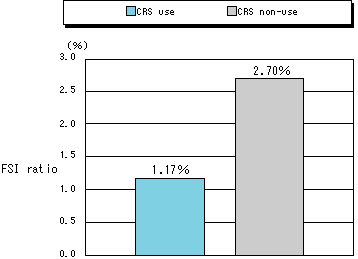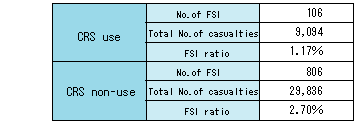 |
||||
|
|||||||
 |
| Figure 1 shows the increase of vehicle occupant casualties in Japan between 1991 and 2000. Statistics for 1991 are translated into the index base value of 1. Among age groups, the steepest rise in casualties was registe red by the child group up to 5 years old. The number of casualties from this child group in 2000 indicated a sharp 2.15 times climb over the 1991 base. In the same nine-year period, however, the increase rate of vehicle occupant casualties from all age groups was a less prominent 1.55 times. |
 Fig.1 Increase of child casualties from road accidents (1991 = 1.0) |
 |
| According to surveys by the National Policy Agency and the JAF (Japan Automobile Federation), Japan saw a remarkable increase in the use of CRS during the year 2000 when the CRS regulation was enacted. The use of CRS and the number of road accident casualties among children are closely linked. As shown in Figure 2, the number of up-to-5 year old casualties during the use of a CRS jumped 2.5 times, from 1,960 casualties in 1999 to 4,917 in 2000. On the other hand, the comparable number during the non-use of a CRS plummeted by 25%, from 7,893 to 5,973. Importantly, these changes in the number of casualties do not imply an ineffectiveness of CRS. The numerical changes were simply due to the widespread use of CRS, which by the law of probability increased the road accidents involving CRS-seated children and decreased the road accidents involving children not seated in a CRS. |
 Fig.2 Up-to-5 year old casualties during CRS use/non-use |
 |
| The child restraint system is not a magic chair capable of guaranteeing total safety from injury, but accident data do indicate that CRS can moderate injuries, often saving the lives of children from otherwise fatal injury. In Japan's traffic accident statistics, casualties are classified into three groups -- "fatality", "serious injury" and "slight injury" -- according to the degree of injury received. Vehicle occupants involved in an accident but sustaining no injury are excluded from these statistics. As a consequence we have decided to apply the concept of FSI ratio to determine the injury immune effect of CRS so as to take full advantage of existing data. As shown by the equation below, the FSI ratio is the percentage of Fatality and Serious Injury cases in the total number of casualties. |
| FSI ratio (%) = (Fatalities + Serious injuries) / Total number of casualties x 100 |
| Figure 3 compares FSI ratios between the use and non-use of a CRS. The FSI ratio for the use of a CRS is 1.17%, meaning that one out of 85 CRS-seated child casualties was either a fatal or serious injury. The FSI ratio for CRS non-using casualties is 2.70%, denoting that one out of 37 CRS non-seated child casualties was a fatal or serious injury. This data suggests the use of CRS has an effect of more than halving the number of fatal and serious injuries. (Note: all the statistics cited in this paper concern passenger cars while excluding other categories of vehicles, in order to make an accurate comparison of CRS effectiveness by applying homogeneous data.) |
 Fig. 3 FSI ratios between CRS use and non-use, 1996-2000 Note: The population - passenger car occupants up to 5 years old |
 |
| UP |
Institute for Traffic Accident Research and Data Analysis (ITARDA) |